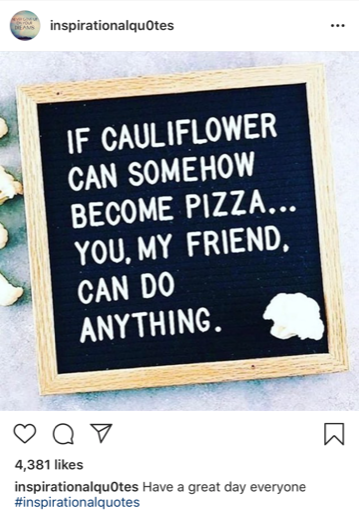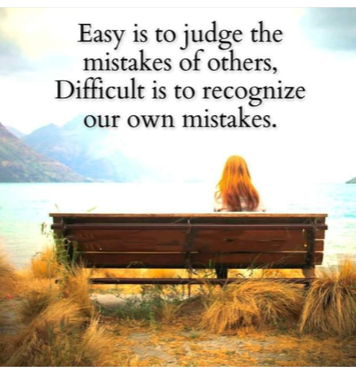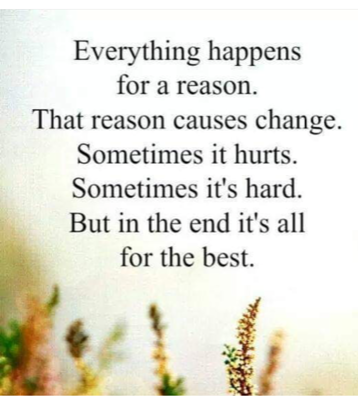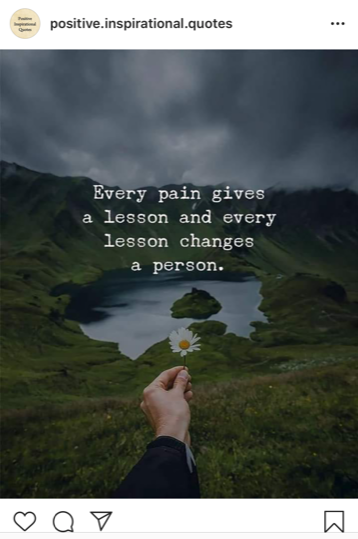Identify and Describe Patterns in the Genre’s Features
- What content is typically included or excluded? How is the content treated? What sorts of examples are used? What counts as evidence (personal testimony, facts, etc.)?
The content included is usually things that happen in life, like going through something bad, making mistakes and even positive things like tomorrow is a new day, God is looking out for you and such. Examples are like breakups, bad days, metaphors, analogies. The types of quotes I am analyzing don’t include common sayings and quotes by famous people. It is mostly just regular inspirational quotes by random people that is part of the content. This content doesn’t require evidence really. As long as it is a quote, is on some kind of background and says anything about life is counts. Evidence may be considered people’s relatability to it. Like if people can relate to it, then it is “evidence” that it is part of this category- it can be considered inspirational to someone in some way. If it is a quote, for example, that no one can relate to because it says something really freaking weird, then it doesn’t count as part of this genre. So I guess really weird or creepy stuff is excluded. And things that are extremely depressing are excluded, only things that are kind of sad can serve as inspirational.
- What rhetorical appeals are used? What appeals to logos, pathos, and ethos appear?
I suppose pathos is the main appeal used in these quotes. The person who posts them tries to get people to like the quotes and follow their pages through things that people can relate to. This is targeting people’s emotions of course. If people feel the same way about the quote or the quote sparks an emotion based on something they have lived, they will agree and potentially be touched by it. The posters they to persuade the readers to agree or like their posts by touching on emotions. For example, “you may feel alone.” Who doesn’t feel alone at least one time in their lives? So readers would read this post and it would remind them of how they felt at some time in their lives. “Everything happens for a reason,” doesn’t everybody have some things happen to them that they don’t understand and/or wish they never happened? This quote would appeal to that.
- How are texts in the genres structured? What are their parts, and how are they organized?
The texts in this genre are not structured or organized in a very specific way. Sometimes they are structured as sort of a problem-solution scenario. For example, “Your life is a result of the choices you make… if you don’t like your life it is time to start making better choices.” The quote states a problem but finished off with the solution to that problem. There are some that are analogies, comparing a life situation to something else. Also, the quotes many times follow a cause and effect structure. For example, “every pain gives a lesson…” The pain is the cause the effect is the lesson it teaches. The parts involved are just a sentence or two that are placed at the center of the image.
- In what format are texts of this genre presented? What layout or appearance is common? How long/big is a typical text in this genre?
These quotes as usually presented in the form of an image. The quotes are all short; the norm is for them to be only one to two sentences long. The sentences are commonly complete sentences with a subject and verb, otherwise they wouldn’t be clear. Fragments for example are not used. The quotes are always in a simple font (nothing fancy) laid out on top on a background, most of the backgrounds include images of nature or a person. Sometimes the backgrounds are just a solid color.
- What types of “sentences” do texts in the genre typically use? How long are they? Are they simple or complex, passive or active? Are the sentences varied? Do they share a certain style?
The quotes usually consist of declarative sentences that just make a statement. They are usually not interrogative or imperative. The sentences are usually just simple sentences, nothing too complicated. Short and to the point. Each quote consists usually of only one to two sentences. The sentences seem to mainly be in active voice. There are a few variations, but most quotes stay within these standards. The style is that they are short and sweet. Also, the sentences are mostly informal. Although the quotes are informal, the grammar is always correct. Usually spelling, punctuation and grammar is correct in these quotes. A quote with a grammar mistake would probably have no credibility. To be legit is has to be grammatically sound. Which is interesting, because although the quotes are informal in their nature, they must be grammatically correct. It is almost contradictory.
- What diction is most common? What types of words (or symbols, images, etc.) are most frequent? Is a type of jargon used? Is slang used? How would you describe a typical writer’s tone?
The quotes are usually addressed to “you,” and use a 2nd person point of view. For example, “your life” and “you” is used a lot. Informal language is used. The words used are not usually complex, just basic vocabulary. Jargon doesn’t seem to be used. Sometimes slang is used but not very often. The writer’s/poster’s tone seems to be serious and matter of fact. Unless the quote is funny, which some of them are. In that case the tone is light-hearted. Interestingly enough, although these quotes are meant to motive and inspire as well as be relatable, they don’t seem to have a tone of empathy. They are just straight and to the point. They just say it how it is. Very cut and dry it seems like.
Analyze What These Patterns Reveal About the Situation and Scene
- What can you learn about the actions being performed through the genre by observing its language patterns?
The language patterns show me that the genre is very informal. The language is colloquial and simple sentences are used. The writer of these quotes is not trying to show off his language skills or be super formal. Quite the opposite, the writer is using these language patterns to connect to his readers. He/she is using language that is accessible because he wants every reader to be able to relate to the quotes. So, the action being performed by the patterns is one of reaching out to the readers.
- How is the subject of the genre treated? What content is considered most important? What content (topics or details) is ignored?
Some may treat the subjects in these quotes as corny or stupid while others may enjoy the quotes and apply them to their lives. The content about the bad things in life, I think are the most important or at least are the ones people pay the most attention to. The quotes about gratitude and becoming successful, for instance, are probably most often ignored. I think that is because the main reason people open these pages to read these quotes is because they are having a hard time and want to know that others have gone through the same situations. The relatability of these quotes is what gets readers to read them. Most people don’t go searching for positive quotes when they are sad, they actually want to see that their pain is shared with others. If that makes any sense. In other words, positive quotes aren’t really what inspires/motivates people, the ones about sucky situations are the ones that encourage people, because they make readers see that they are not alone in their suffering.
- What values, beliefs, goals, and assumptions are revealed through the genre’s patterns?
The beliefs that are revealed through this genre’s patterns is that sucky things happen in life, and they are a part of life. The fact that these quotes are usually not too empathetic show that to readers it doesn’t really matter how the quote is said (if it seems like the poster/writer care about the person’s problems), it just matters that they can relate to the situation/issue/topic that the quote is about. Just the notion that the issue is out there, shows readers that others are/have experienced the same thing. That is what comforts people. I think that the conclusion I have is that the truly inspirational aspects of the quotes aren’t the positive parts or the resolution to the issues. The inspirational aspect is the feeling the you are not alone; your issue is someone else’s issue. Also, I think the people take what they need from the quotes, which may not necessarily be the whole quote or might not be the goal of the writer. If a person reads a quote, and a specific word or idea about the quote inspires them, it doesn’t matter what the purpose of the writer is, it matters that the reader found a use for the quote—a use that serves the purpose he/she needs it to serve.
- What actions does the genre enable? What actions does the genre constrain??
This genre enables emotional support for readers. It may not seem like it superficially, but there are people out there that are actually inspired and motivated by these quotes. Sometimes people have no friends to talk to about their issues. Other times, people may have friends, but those friends haven’t been through what they are going through and are not as understanding as they need them to be. There may even be people who are ashamed to talk about their hardships or afraid to seem vulnerable to others. Whatever the reason, these quotes show people they are normal and are not alone. These quotes also enable communication between people. For example, you may have a friend who is going through something and you see a quote that is perfect for that friend. You can send your friend that image and that may serve as a conversation starter for the person to open up to you This genre enables being real and raw. It enables transparency. I’m not sure if this genre constrains anything.
- What do these patterns reveal about the genre, its situation, and the people who use it?
These patterns seem to reveal that the sayings don’t have to be that meaningful in order to be considered part of this genre. In order to be considered part of the “pattern” the quote just has to be short and on a background. The quotes must talk about a situation of “life” in order to be included as inspirational quote genre. The people who use these quotes, for example, people who use them as motivation, must be touched by them. Therefore, it is fair to say that the pathos appeal is a significant part of what makes this genre what it is. People should be able to relate to the quotes and be moved by them, enough to keep the page going. When it comes to those who post these quotes, it is uncertain whether their purpose is to make their page grow or if they truly want to help people with the things they post.
- What do participants have to know or believe to understand or appreciate the genre?
In order to understand the genre, participants only have to be able to read them. Sometimes, they have to have gone through something similar in order to truly understand some quotes. To believe the quotes, participants must agree with them. There are some quotes readers may not believe or agree with and others they do agree with. Either way, participants that understand the quotes and have a certain level of ability to relate to most of them will be able to appreciate this genre.
- Who is invited into the genre, and who is excluded?
I believe everyone in invited into this genre. There is no exclusion. The quotes are there for all to read and reflect on. They can inspire anybody of any cultural background and any age. They may make more sense to some people than to others, but no one is excluded from reading the quotes. Because I am talking specifically about inspirational quotes on Instagram pages, it can be said that the ones excluded are the ones who are not following a page, if that page is private. Still, if the page is private, all the person has to do is request to follow the page and that exclusion will no longer exist.
- What roles for writers and readers does it encourage or discourage?
These quotes encourage writers/ or posters really to express themselves. It encourages writers to be creative and posters to have that role of “inspirer” in the readers lives. The quotes encourage readers to look to them for inspiration and motivation. It pretty much sets up the posters as the “givers” and the readers to “receivers.”






